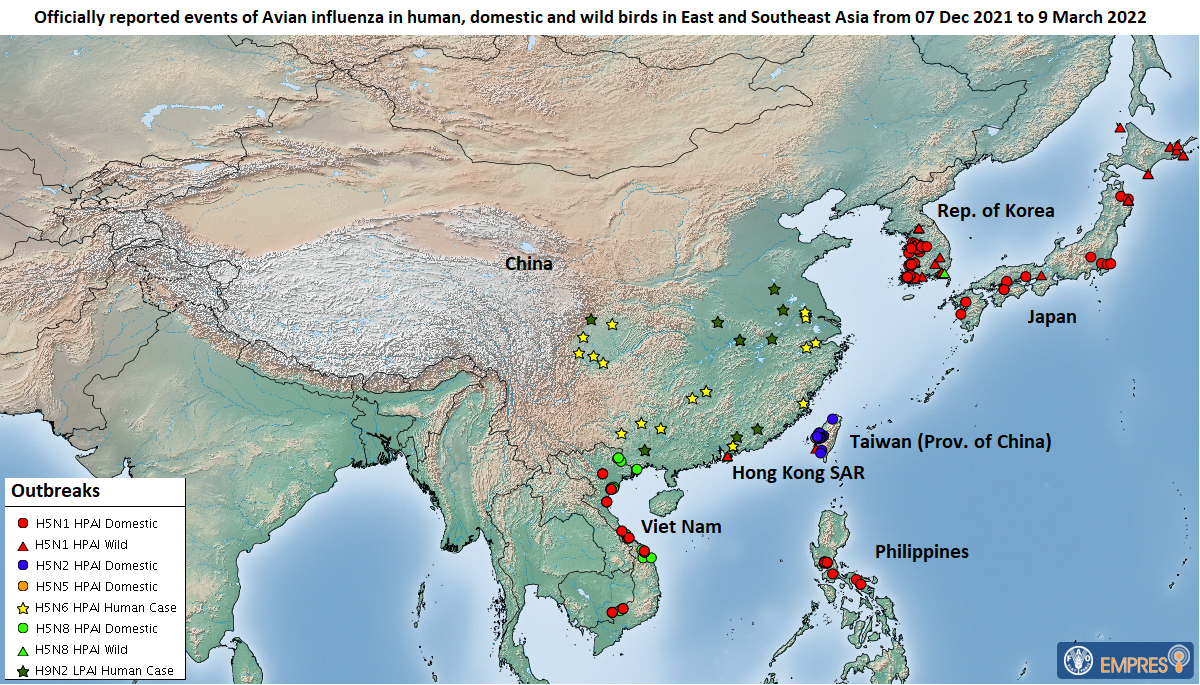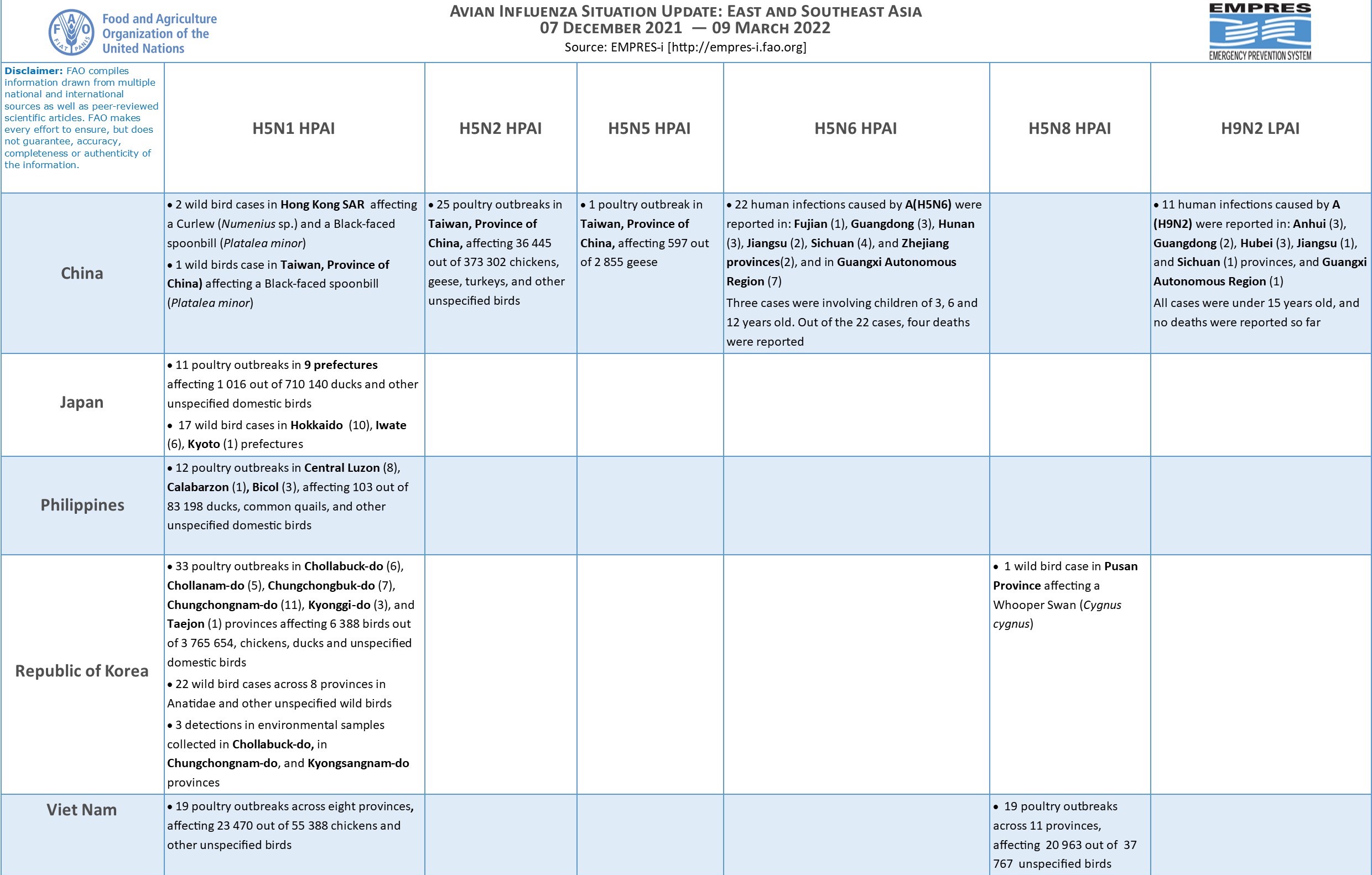Source: https://www.eaaflyway.net/avian-infl...-dec-mar-2022/
Updates of worldwide avian influenza situation by FAO/EMPRES-AH (Dec 2021 – Mar 2022)
Posted on March 14, 2022 Categories: All News
FAO/EMPRES-AH is constantly monitoring the avian influenza situation worldwide and compiles information from multiple national and international sources as well as peer-reviewed scientific articles. Close collaboration with country and regional offices, the implementation of avian influenza field surveillance projects, and networks of expertise like OIE/FAO’s OFFLU (www.offlu.org) provide access to timely information on outbreaks, surveillance findings, and genetic similarities of circulating viruses or their virological features. This information is stored in the EMPRES Global Animal Disease Information System (EMPRES-i), a database that can be accessed online at empres-i.apps.fao.org.
 EAAFP March 2022 Map © EMPRES
EAAFP March 2022 Map © EMPRES
During the period 7 December to 9 March 2022, five highly pathogenic avian influenza (HPAI) virus subtypes (H5N1, H5N2, H5N5, H5N6, and H5N8) and one low pathogenic avian influenza (LPAI) virus subtype (H9N2) have been reported in East and South-East Asia. H5Nx HPAI viruses continue to circulate in Asia and are well established in certain areas of the region. Viet Nam officially reported 38 HPAI outbreaks in domestic birds across the country caused by both H5N1 (19) and H5N8 (19) virus subtypes, with a higher number of outbreaks distributed in the central and Northern part of the country. In Japan, 12 H5N1 HPAI poultry outbreaks were observed amongst nine prefectures affecting domestic ducks, chickens, and quails while 17 H5N1 HPAI detections in wild birds were reported from Hokkaido (10), Iwate (6), and Kyoto (1) prefectures involving Eastern buzzard (Buteo japonicas), Large-billed Crow (Corvus macrorhynchos), White tailed eagle (Haliaeetus albicilla), and Whooper Swan (Cygnus Cygnus). In the Republic of Korea, H5N1 HPAI virus caused 33 poultry outbreaks in six provinces affecting domestic ducks, chickens, and quails, and the virus was also reported in 22 wild bird cases across nine provinces involving majorly Anatidae as well as few detections in environmental samples collected from wild bird feces. In addition, H5N8 HPAI virus was detected in a dead Whooper Swan (Cygnus Cygnus) in Pusan Province, Republic of Korea. China reported three H5N1 HPAI wild bird cases in Hong Kong Special Administrative Region and Taiwan Province, affecting one Curlew (Numenius sp.) and two Black-faced Spoonbills (Platalea minor). H5N2 HPAI virus has flared up in Taiwan Province, China during the covered period with a total of 25 outbreaks reported in domestic birds including ducks, geese, chickens, and turkeys while only one H5N5 HPAI outbreak was reported in domestic geese. Notably, H5N1 HPAI was re-introduced in the Philippines causing 12 outbreaks in domestic birds including ducks and quails and other unspecified birds; the latest HPAI outbreak before this was observed on 10 August 2020.
Furthermore, China reported a total of twenty-two A(H5N6) human infections in Fujian (1), Guangdong (3), Hunan (3), Jiangsu (2), Sichuan (4), and Zhejiang provinces (2), and in Guangxi Autonomous Region (7), including four deaths. Three cases were involving children. Since 2014, 74 A(H5N6) human infections were reported globally and 73 of them occurred in Mainland China, the latest case being reported on 8 March 2022. In addition, eleven human infections caused by A(H9N2) were reported in Anhui (3), Guangdong (2), Hubei (3), Jiangsu (1), and Sichuan (1) provinces, and in Guangxi Autonomous Region (1). All cases were below fifteen years old and no deaths were reported to date.
Highly pathogenic H5N1, H5N2, H5N5, H5N6, and H5N8 viruses have demonstrated the ability to spread via migratory water birds.
We consider avian influenza activity to be highest in the period from December to March, therefore reports of outbreaks in poultry or detections in wild birds and humans are not expected to increase over the coming months in the region.


Updates of worldwide avian influenza situation by FAO/EMPRES-AH (Dec 2021 – Mar 2022)
Posted on March 14, 2022 Categories: All News
FAO/EMPRES-AH is constantly monitoring the avian influenza situation worldwide and compiles information from multiple national and international sources as well as peer-reviewed scientific articles. Close collaboration with country and regional offices, the implementation of avian influenza field surveillance projects, and networks of expertise like OIE/FAO’s OFFLU (www.offlu.org) provide access to timely information on outbreaks, surveillance findings, and genetic similarities of circulating viruses or their virological features. This information is stored in the EMPRES Global Animal Disease Information System (EMPRES-i), a database that can be accessed online at empres-i.apps.fao.org.
 EAAFP March 2022 Map © EMPRES
EAAFP March 2022 Map © EMPRESDuring the period 7 December to 9 March 2022, five highly pathogenic avian influenza (HPAI) virus subtypes (H5N1, H5N2, H5N5, H5N6, and H5N8) and one low pathogenic avian influenza (LPAI) virus subtype (H9N2) have been reported in East and South-East Asia. H5Nx HPAI viruses continue to circulate in Asia and are well established in certain areas of the region. Viet Nam officially reported 38 HPAI outbreaks in domestic birds across the country caused by both H5N1 (19) and H5N8 (19) virus subtypes, with a higher number of outbreaks distributed in the central and Northern part of the country. In Japan, 12 H5N1 HPAI poultry outbreaks were observed amongst nine prefectures affecting domestic ducks, chickens, and quails while 17 H5N1 HPAI detections in wild birds were reported from Hokkaido (10), Iwate (6), and Kyoto (1) prefectures involving Eastern buzzard (Buteo japonicas), Large-billed Crow (Corvus macrorhynchos), White tailed eagle (Haliaeetus albicilla), and Whooper Swan (Cygnus Cygnus). In the Republic of Korea, H5N1 HPAI virus caused 33 poultry outbreaks in six provinces affecting domestic ducks, chickens, and quails, and the virus was also reported in 22 wild bird cases across nine provinces involving majorly Anatidae as well as few detections in environmental samples collected from wild bird feces. In addition, H5N8 HPAI virus was detected in a dead Whooper Swan (Cygnus Cygnus) in Pusan Province, Republic of Korea. China reported three H5N1 HPAI wild bird cases in Hong Kong Special Administrative Region and Taiwan Province, affecting one Curlew (Numenius sp.) and two Black-faced Spoonbills (Platalea minor). H5N2 HPAI virus has flared up in Taiwan Province, China during the covered period with a total of 25 outbreaks reported in domestic birds including ducks, geese, chickens, and turkeys while only one H5N5 HPAI outbreak was reported in domestic geese. Notably, H5N1 HPAI was re-introduced in the Philippines causing 12 outbreaks in domestic birds including ducks and quails and other unspecified birds; the latest HPAI outbreak before this was observed on 10 August 2020.
Furthermore, China reported a total of twenty-two A(H5N6) human infections in Fujian (1), Guangdong (3), Hunan (3), Jiangsu (2), Sichuan (4), and Zhejiang provinces (2), and in Guangxi Autonomous Region (7), including four deaths. Three cases were involving children. Since 2014, 74 A(H5N6) human infections were reported globally and 73 of them occurred in Mainland China, the latest case being reported on 8 March 2022. In addition, eleven human infections caused by A(H9N2) were reported in Anhui (3), Guangdong (2), Hubei (3), Jiangsu (1), and Sichuan (1) provinces, and in Guangxi Autonomous Region (1). All cases were below fifteen years old and no deaths were reported to date.
Highly pathogenic H5N1, H5N2, H5N5, H5N6, and H5N8 viruses have demonstrated the ability to spread via migratory water birds.
We consider avian influenza activity to be highest in the period from December to March, therefore reports of outbreaks in poultry or detections in wild birds and humans are not expected to increase over the coming months in the region.


Comment